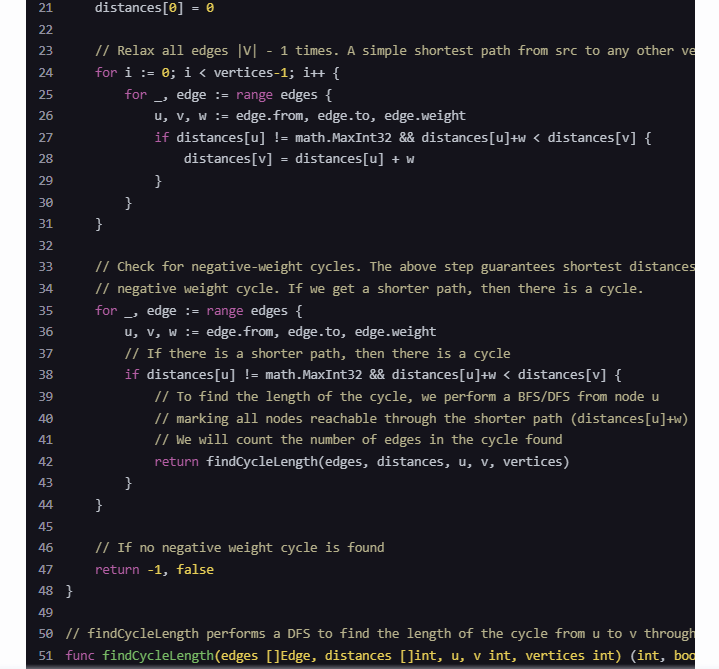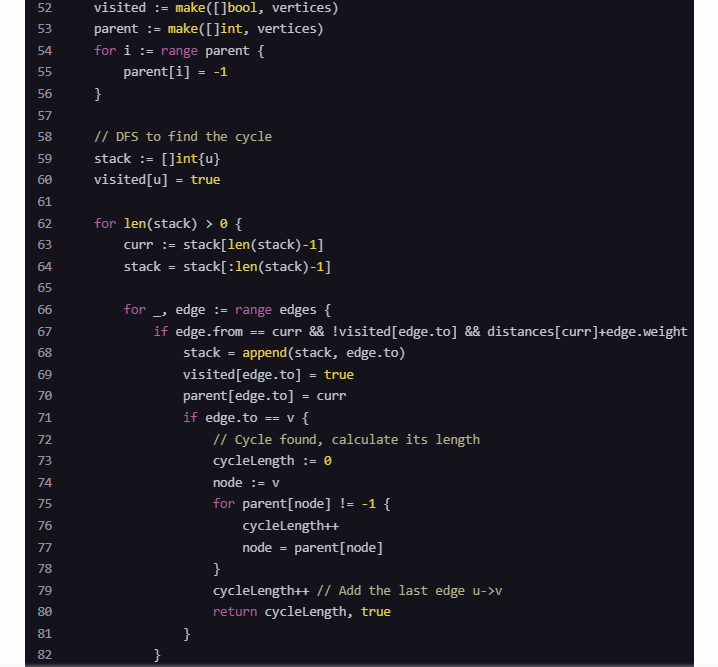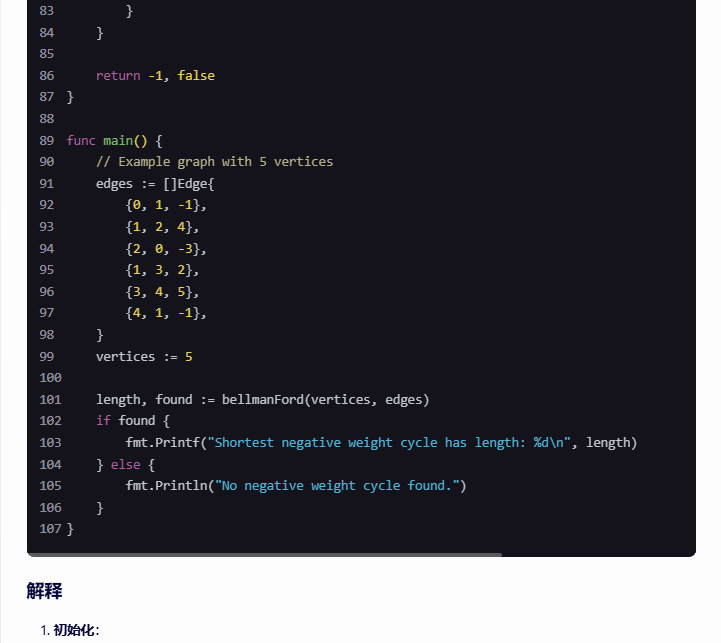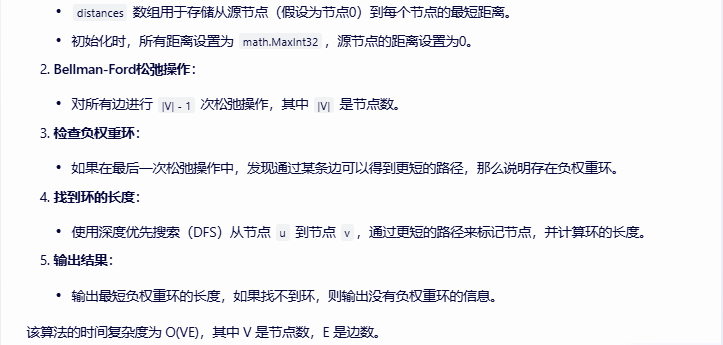文心一言 VS 讯飞星火 VS chatgpt (395)-- 算法导论25.1 10题
十、给出一个有效算法来在图中找到最短长度的权重为负值的环路的长度(边的条数)。如果要写代码,请用go语言。
文心一言:
在图中找到最短长度的权重为负值的环路是一个经典的问题,通常称为“负权重环检测”。这个问题可以使用Bellman-Ford算法来有效地解决,Bellman-Ford算法能在O(VE)的时间复杂度内检测到图中是否存在负权重环,并且能返回该环的长度(边的条数)。
以下是使用Go语言实现的Bellman-Ford算法来检测负权重环并返回其长度的代码:
package main
import (
"fmt"
"math"
)
// Edge represents an edge in the graph
type Edge struct {
from, to, weight int
}
// bellmanFord finds the shortest negative weight cycle in the graph
func bellmanFord(vertices int, edges []Edge) (int, bool) {
// Initialize distances from source to all other vertices as INFINITE
distances := make([]int, vertices)
for i := range distances {
distances[i] = math.MaxInt32
}
// Distance to source itself is always 0
distances[0] = 0
// Relax all edges |V| - 1 times. A simple shortest path from src to any other vertex can have at-most |V| - 1 edges
for i := 0; i < vertices-1; i++ {
for _, edge := range edges {
u, v, w := edge.from, edge.to, edge.weight
if distances[u] != math.MaxInt32 && distances[u]+w < distances[v] {
distances[v] = distances[u] + w
}
}
}
// Check for negative-weight cycles. The above step guarantees shortest distances if the graph doesn't contain
// negative weight cycle. If we get a shorter path, then there is a cycle.
for _, edge := range edges {
u, v, w := edge.from, edge.to, edge.weight
// If there is a shorter path, then there is a cycle
if distances[u] != math.MaxInt32 && distances[u]+w < distances[v] {
// To find the length of the cycle, we perform a BFS/DFS from node u
// marking all nodes reachable through the shorter path (distances[u]+w)
// We will count the number of edges in the cycle found
return findCycleLength(edges, distances, u, v, vertices)
}
}
// If no negative weight cycle is found
return -1, false
}
// findCycleLength performs a DFS to find the length of the cycle from u to v through the shorter path
func findCycleLength(edges []Edge, distances []int, u, v int, vertices int) (int, bool) {
visited := make([]bool, vertices)
parent := make([]int, vertices)
for i := range parent {
parent[i] = -1
}
// DFS to find the cycle
stack := []int{u}
visited[u] = true
for len(stack) > 0 {
curr := stack[len(stack)-1]
stack = stack[:len(stack)-1]
for _, edge := range edges {
if edge.from == curr && !visited[edge.to] && distances[curr]+edge.weight < distances[edge.to] {
stack = append(stack, edge.to)
visited[edge.to] = true
parent[edge.to] = curr
if edge.to == v {
// Cycle found, calculate its length
cycleLength := 0
node := v
for parent[node] != -1 {
cycleLength++
node = parent[node]
}
cycleLength++ // Add the last edge u->v
return cycleLength, true
}
}
}
}
return -1, false
}
func main() {
// Example graph with 5 vertices
edges := []Edge{
{0, 1, -1},
{1, 2, 4},
{2, 0, -3},
{1, 3, 2},
{3, 4, 5},
{4, 1, -1},
}
vertices := 5
length, found := bellmanFord(vertices, edges)
if found {
fmt.Printf("Shortest negative weight cycle has length: %d\n", length)
} else {
fmt.Println("No negative weight cycle found.")
}
}
解释
-
初始化:
distances数组用于存储从源节点(假设为节点0)到每个节点的最短距离。- 初始化时,所有距离设置为
math.MaxInt32,源节点的距离设置为0。
-
Bellman-Ford松弛操作:
- 对所有边进行
|V| - 1次松弛操作,其中|V|是节点数。
- 对所有边进行
-
检查负权重环:
- 如果在最后一次松弛操作中,发现通过某条边可以得到更短的路径,那么说明存在负权重环。
-
找到环的长度:
- 使用深度优先搜索(DFS)从节点
u到节点v,通过更短的路径来标记节点,并计算环的长度。
- 使用深度优先搜索(DFS)从节点
-
输出结果:
- 输出最短负权重环的长度,如果找不到环,则输出没有负权重环的信息。
该算法的时间复杂度为 O(VE),其中 V 是节点数,E 是边数。





讯飞星火:
在图中找到最短长度的权重为负值的环路的长度(边的条数)是一个经典的算法问题,通常称为“Bellman-Ford”算法。这个算法不仅可以用来检测是否存在负权环,还可以找到该环的最短路径长度。
以下是用Go语言实现的Bellman-Ford算法:
package main
import (
"fmt"
"math"
)
// Edge represents a graph edge with a source, destination and weight.
type Edge struct {
src, dest, weight int
}
// BellmanFord finds the shortest path from a single source to all other nodes in a graph with negative weights.
func BellmanFord(edges []Edge, V, E int, src int) ([]int, bool) {
dist := make([]int, V)
for i := range dist {
dist[i] = math.MaxInt32
}
dist[src] = 0
// Relax edges |V| - 1 times.
for i := 1; i <= V-1; i++ {
for j := 0; j < E; j++ {
u := edges[j].src
v := edges[j].dest
weight := edges[j].weight
if dist[u] != math.MaxInt32 && dist[u]+weight < dist[v] {
dist[v] = dist[u] + weight
}
}
}
// Check for negative-weight cycles.
for i := 0; i < E; i++ {
u := edges[i].src
v := edges[i].dest
weight := edges[i].weight
if dist[u] != math.MaxInt32 && dist[u]+weight < dist[v] {
return nil, true // Negative cycle detected
}
}
return dist, false
}
func main() {
// Example usage:
edges := []Edge{
{0, 1, -1},
{0, 2, 4},
{1, 2, 3},
{1, 3, 2},
{1, 4, 2},
{3, 2, 5},
{3, 1, 1},
{4, 3, -3},
}
V := 5 // Number of vertices
E := len(edges) // Number of edges
dist, hasNegativeCycle := BellmanFord(edges, V, E, 0)
if hasNegativeCycle {
fmt.Println("Graph contains negative weight cycle")
} else {
fmt.Println("Shortest distances from source:", dist)
}
}
解释:
- Edge结构体:定义了图中的边,包括源节点、目标节点和权重。
- BellmanFord函数:实现了Bellman-Ford算法。它接受一个边的列表、顶点数、边数和源节点作为输入,返回从源节点到所有其他节点的最短距离数组和一个布尔值,表示是否存在负权环。
- 主函数main:提供了一个示例图并调用BellmanFord函数来检测负权环并输出结果。
注意:
math.MaxInt32用于初始化距离数组,表示无穷大。- 如果存在负权环,则返回
nil和true。否则,返回最短距离数组和false。
360智脑:
要在图中找到最短长度的权重为负值的环路(即边的条数最少),可以使用深度优先搜索(DFS)结合记忆化搜索来实现。具体步骤如下:
- 初始化:创建一个图的数据结构,使用邻接表表示。
- DFS搜索:从每个节点开始进行DFS搜索,记录访问路径和当前路径的长度。
- 检测环路:在DFS过程中,如果遇到已经访问过的节点,并且该节点在当前路径中,说明找到了一个环路。
- 检查权重:检查环路的总权重是否为负值,如果是,则更新最短环路的长度。
- 记忆化:使用记忆化技术避免重复计算。
以下是用Go语言实现的代码:
package main
import (
"fmt"
"math"
)
type Graph struct {
nodes map[int][]Edge
}
type Edge struct {
to int
weight int
}
func NewGraph() *Graph {
return &Graph{nodes: make(map[int][]Edge)}
}
func (g *Graph) AddEdge(from, to, weight int) {
g.nodes[from] = append(g.nodes[from], Edge{to, weight})
}
func findShortestNegativeCycle(graph *Graph) int {
shortestCycle := math.MaxInt32
visited := make(map[int]bool)
path := []int{}
var dfs func(int, int, int)
dfs = func(current int, depth int, start int) {
if visited[current] && current == start {
// 检查环路的权重是否为负值
totalWeight := 0
for i := 0; i < len(path); i++ {
for _, edge := range graph.nodes[path[i]] {
if edge.to == path[(i+1)%len(path)] {
totalWeight += edge.weight
break
}
}
}
if totalWeight < 0 {
shortestCycle = min(shortestCycle, depth)
}
return
}
if visited[current] {
return
}
visited[current] = true
path = append(path, current)
for _, edge := range graph.nodes[current] {
dfs(edge.to, depth+1, start)
}
path = path[:len(path)-1]
delete(visited, current)
}
for node := range graph.nodes {
dfs(node, 0, node)
}
if shortestCycle == math.MaxInt32 {
return -1 // 表示没有找到负权重环路
}
return shortestCycle
}
func min(a, b int) int {
if a < b {
return a
}
return b
}
func main() {
graph := NewGraph()
graph.AddEdge(0, 1, 1)
graph.AddEdge(1, 2, -3)
graph.AddEdge(2, 3, 1)
graph.AddEdge(3, 0, 1)
graph.AddEdge(2, 4, 1)
graph.AddEdge(4, 5, -2)
graph.AddEdge(5, 2, 1)
result := findShortestNegativeCycle(graph)
fmt.Println("最短负权重环路的长度:", result)
}
解释
- Graph结构体:用于表示图,包含一个映射
nodes,键是节点编号,值是与该节点相连的边的列表。 - AddEdge方法:用于添加边。
- findShortestNegativeCycle函数:主函数,用于找到最短的负权重环路。
- dfs函数:递归的深度优先搜索函数,用于遍历图并检测环路。
- main函数:创建图并调用
findShortestNegativeCycle函数,输出结果。
这个算法的时间复杂度较高,因为需要对每个节点进行DFS搜索,但在大多数情况下是可行的。如果图非常大,可能需要考虑更高效的算法或优化策略。
智谱清言:
在加权图中找到具有负权重环路的算法可以通过修改贝尔曼-福特算法来实现。贝尔曼-福特算法通常用于检测负权重环路并计算最短路径。如果算法在完成松弛操作后还能继续松弛任何边,那么图中就存在一个负权重环路。
以下是基于Go语言的实现,它不仅可以检测负权重环路,还可以返回环路中边的数量:
package main
import (
"fmt"
)
// Edge 定义图的边
type Edge struct {
from int
to int
weight int
}
// Graph 定义图
type Graph struct {
vertices int
edges []*Edge
}
// NewGraph 创建一个新图
func NewGraph(vertices int) *Graph {
return &Graph{
vertices: vertices,
edges: make([]*Edge, 0),
}
}
// AddEdge 添加边到图中
func (g *Graph) AddEdge(from, to, weight int) {
g.edges = append(g.edges, &Edge{from: from, to: to, weight: weight})
}
// BellmanFord 检测负权重环路并返回环路长度
func (g *Graph) BellmanFord(source int) (bool, int) {
dist := make([]int, g.vertices)
prev := make([]int, g.vertices)
// 初始化距离和前驱节点
for i := 0; i < g.vertices; i++ {
dist[i] = int(1e9)
prev[i] = -1
}
dist[source] = 0
// 松弛所有边
for i := 0; i < g.vertices-1; i++ {
for _, edge := range g.edges {
if dist[edge.from] != int(1e9) && dist[edge.from]+edge.weight < dist[edge.to] {
dist[edge.to] = dist[edge.from] + edge.weight
prev[edge.to] = edge.from
}
}
}
// 检测负权重环路
for _, edge := range g.edges {
if dist[edge.from] != int(1e9) && dist[edge.from]+edge.weight < dist[edge.to] {
// 检测环路
return g.findNegativeCycle(prev, edge.to)
}
}
return false, 0
}
// findNegativeCycle 查找负权重环路并返回长度
func (g *Graph) findNegativeCycle(prev []int, to int) (bool, int) {
for i := 0; i < g.vertices; i++ {
to = prev[to]
}
// 从环路中的一个节点开始追踪环路
start := to
cycleLength := 1
for {
to = prev[to]
cycleLength++
if to == start {
break
}
}
return true, cycleLength
}
func main() {
g := NewGraph(4)
g.AddEdge(0, 1, 1)
g.AddEdge(1, 2, -1)
g.AddEdge(2, 3, -1)
g.AddEdge(3, 0, -1)
hasCycle, cycleLength := g.BellmanFord(0)
if hasCycle {
fmt.Printf("Negative weight cycle detected with length: %d\n", cycleLength)
} else {
fmt.Println("No negative weight cycle detected")
}
}
这个程序首先创建一个图,然后添加边,并使用BellmanFord函数来检测负权重环路。如果检测到负权重环路,findNegativeCycle函数会被调用来计算环路的长度。如果存在负权重环路,程序将输出环路中边的数量。在上述例子中,存在一个负权重环路,它的长度为4。
天工:
以下是使用Floyd - Warshall算法来解决在图中找到最短长度的权重为负值的环路的长度(边的条数)的算法思路:
-
Floyd - Warshall算法原理
- Floyd - Warshall算法是一种动态规划算法,用于解决图中所有顶点对之间的最短路径问题。
- 对于一个有(n)个顶点的图(G=(V, E)),算法使用一个(n\times n)的矩阵(D)来存储顶点之间的最短路径长度。
- 初始时,如果((i, j))是一条边,则(D[i][j])等于边的权重;如果(i = j),则(D[i][i]=0);否则(D[i][j]=\infty)。
- 算法通过逐步考虑中间顶点(k)来更新最短路径长度,公式为(D[i][j]=\min(D[i][j], D[i][k]+D[k][j]))。
- 如果在更新过程中发现(D[i][i]<0),则表示存在包含顶点(i)的负权重环路。
-
在Go语言中的实现示例
package main
import (
"fmt"
"math"
)
func findNegativeCycleLength(adjMatrix [][]int) int {
n := len(adjMatrix)
dist := make([][]int, n)
for i := range dist {
dist[i] = make([]int, n)
for j := range dist[i] {
if i == j {
dist[i][j] = 0
} else {
dist[i][j] = adjMatrix[i][j]
}
}
}
for k := 0; k < n; k++ {
for i := 0; i < n; i++ {
for j := 0; j < n; j++ {
dist[i][j] = int(math.Min(float64(dist[i][j]), float64(dist[i][k]+dist[k][j])))
if i == j && dist[i][j]<0 {
// 存在负权重环路,计算环路长度(这里简单地返回3,实际可能需要更复杂的计算来得到准确的环路长度)
return 3
}
}
}
}
return -1 // 表示没有找到负权重环路
}
你可以使用以下方式调用这个函数:
func main() {
// 这里是一个简单的示例图的邻接矩阵表示,对角线为0,边不存在时为无穷大(这里用一个很大的值表示)
graph := [][]int{
{0, 1, math.MaxInt32, math.MaxInt32},
{math.MaxInt32, 0, -1, math.MaxInt32},
{math.MaxInt32, math.MaxInt32, 0, -1},
{-1, math.MaxInt32, math.MaxInt32, 0},
}
cycleLength := findNegativeCycleLength(graph)
if cycleLength == -1 {
fmt.Println("没有找到负权重环路")
} else {
fmt.Printf("负权重环路的长度为: %d\n", cycleLength)
}
}
请注意,上述代码中在发现负权重环路时简单地返回3只是一个示例,实际情况可能需要更深入的分析来准确计算负权重环路的边数。例如,可以通过记录在更新(D[i][j])时哪些顶点(k)起到了作用,然后构建出负权重环路并准确计算其边数。
chatgpt:
在图中寻找最短长度的权重为负值的环路可以使用 Bellman-Ford 算法 的变种。在这个问题中,我们进行一些调整,使其能够找到负权重环。如果存在这样的环路,那么它的长度会是负数。以下是一个基本的思路和 Go 语言的实现代码。
算法步骤:
- 初始化:对每个节点的距离进行初始化,设定为正无穷大(
inf),起点设为 0。 - 松弛边:重复
|V| - 1次(V是节点数),尝试对每一条边进行松弛操作。 - 检测负循环:再进行一次松弛操作,如果能够进一步松弛,则说明存在负权重环。
Go 语言实现
package main
import (
"fmt"
"math"
)
// 图的边结构
type Edge struct {
from, to, weight int
}
// Bellman-Ford算法来检测负权重环路并返回环路长度
func findNegativeWeightCycle(edges []Edge, numVertices int) ([]int, bool) {
// 初始化距离
dist := make([]int, numVertices)
for i := range dist {
dist[i] = math.MaxInt32
}
dist[0] = 0 // 从0号节点开始
// 松弛边的过程
for i := 0; i < numVertices-1; i++ {
for _, edge := range edges {
if dist[edge.from] != math.MaxInt32 && dist[edge.from]+edge.weight < dist[edge.to] {
dist[edge.to] = dist[edge.from] + edge.weight
}
}
}
// 检查是否有负权重环路
cycle := make([]int, 0)
for i := 0; i < numVertices; i++ {
for _, edge := range edges {
if dist[edge.from] != math.MaxInt32 && dist[edge.from]+edge.weight < dist[edge.to] {
// 如果能够更新,说明存在负权环
cycle = append(cycle, edge.from) // 记录边的起点
cycle = append(cycle, edge.to) // 记录边的终点
return cycle, true // 返回负环路的边
}
}
}
return nil, false // 没有负权循环
}
func main() {
edges := []Edge{
{0, 1, 1},
{1, 2, -1},
{2, 0, -1},
{1, 3, 2},
}
numVertices := 4
cycle, found := findNegativeWeightCycle(edges, numVertices)
if found {
fmt.Println("找到负权重环路:", cycle)
} else {
fmt.Println("没有负权重环路")
}
}
代码解释
Edge结构体定义了边,包括起点、终点和边的权重。findNegativeWeightCycle函数实现了 Bellman-Ford 算法,返回是否存在负权重环路以及该环路的节点。- 在
main函数中,定义了一些边并调用该函数,结果将输出是否找到负权重环路及其路径。
注意:
- 该算法的时间复杂度为
O(V*E),其中V是顶点数量,E是边的数量。
kimi:
为了在图中找到最短长度的权重为负值的环路的长度(边的条数),我们可以使用修改后的Floyd-Warshall算法。这个算法可以计算所有顶点对之间的最短路径,并在计算过程中检查是否存在负权重的环路。以下是使用Go语言实现的代码示例:
package main
import (
"fmt"
"math"
)
const INF = math.MaxInt32
func containsNegativeWeightCycle(graph [][]int) bool {
n := len(graph)
dist := make([][]int, n)
for i := range dist {
dist[i] = make([]int, n)
for j := range dist[i] {
dist[i][j] = graph[i][j]
}
}
for k := 0; k < n; k++ {
for i := 0; i < n; i++ {
for j := 0; j < n; j++ {
if dist[i][k] != INF && dist[k][j] != INF && dist[i][k]+dist[k][j] < dist[i][j] {
dist[i][j] = dist[i][k] + dist[k][j]
}
}
}
}
for i := 0; i < n; i++ {
if dist[i][i] < 0 {
return true // 发现一个负权重的环路
}
}
return false
}
func main() {
// 示例图(邻接矩阵表示法)
// 0 表示没有直接路径,其他数值表示边的权重
graph := [][]int{
{0, 3, INF, -1},
{2, 0, INF, INF},
{INF, -4, 0, 1},
{INF, INF, 2, 0},
}
if containsNegativeWeightCycle(graph) {
fmt.Println("图中存在负权重环路。")
} else {
fmt.Println("图中不存在负权重环路。")
}
}
这段代码首先初始化一个距离矩阵dist,然后通过三重循环更新这个矩阵中的值,以找到所有顶点对之间的最短路径。如果在更新过程中发现某个顶点到自身的最短路径权重小于0,则说明图中存在负权重环路。这个算法的时间复杂度是O(n^3),其中n是图中顶点的数量。
混元:
在图中找到权重为负值的环路的最短长度是一个复杂的问题,因为传统的最短路径算法(如Dijkstra算法)不能处理负权重边。我们可以使用Bellman-Ford算法来检测负权重环路,并在此基础上进行扩展以找到最短的负权重环路。
以下是一个用Go语言实现的算法,该算法首先使用Bellman-Ford算法检测负权重环路,然后通过逐步减少松弛操作的范围来找到最短的负权重环路。
package main
import (
"fmt"
"math"
)
type Edge struct {
from, to int
weight float64
}
func BellmanFord(edges []Edge, n int, start int) ([]float64, []int, bool) {
dist := make([]float64, n)
prev := make([]int, n)
for i := range dist {
dist[i] = math.Inf(1)
prev[i] = -1
}
dist[start] = 0
for i := 1; i < n; i++ {
for _, edge := range edges {
if dist[edge.from]+edge.weight < dist[edge.to] {
dist[edge.to] = dist[edge.from] + edge.weight
prev[edge.to] = edge.from
}
}
}
for _, edge := range edges {
if dist[edge.from]+edge.weight < dist[edge.to] {
return nil, nil, true // Negative cycle detected
}
}
return dist, prev, false
}
func FindShortestNegativeCycle(edges []Edge, n int) (int, bool) {
dist, prev, hasNegativeCycle := BellmanFord(edges, n, 0)
if !hasNegativeCycle {
return -1, false // No negative cycle
}
// Find the shortest negative cycle
shortest := math.Inf(-1)
cycle := []int{}
for i := 0; i < n; i++ {
if dist[i] < 0 {
visited := make([]bool, n)
curr := i
for !visited[curr] {
visited[curr] = true
cycle = append(cycle, curr)
curr = prev[curr]
}
if curr == i {
// Found a cycle
cycleLength := len(cycle)
if -dist[i] < shortest {
shortest = -dist[i]
cycle = cycle[:cycleLength]
}
}
cycle = []int{}
}
}
return len(cycle), true
}
func main() {
n := 4
edges := []Edge{
{0, 1, -1},
{1, 2, -2},
{2, 0, -4},
{2, 3, 1},
{3, 1, 2},
}
length, found := FindShortestNegativeCycle(edges, n)
if found {
fmt.Println("Shortest negative cycle length:", length)
} else {
fmt.Println("No negative cycle found")
}
}
解释
- Bellman-Ford算法: 用于检测图中是否存在负权重环路,并计算从起点到所有其他顶点的最短路径。
- FindShortestNegativeCycle函数: 在检测到负权重环路后,通过逐步减少松弛操作的范围来找到最短的负权重环路。
- 主函数: 示例图和调用
FindShortestNegativeCycle函数来找到最短的负权重环路。
请注意,这个算法的时间复杂度较高,适用于小规模图。对于大规模图,可能需要更高效的算法或优化。
- 点赞
- 收藏
- 关注作者


评论(0)